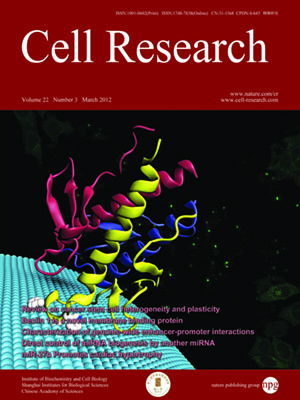
Volume 22, No 3, Mar 2012
ISSN: 1001-0602
EISSN: 1748-7838 2018
impact factor 17.848*
(Clarivate Analytics, 2019)
Volume 22 Issue 3, March 2012: 504-515
ORIGINAL ARTICLES
Mouse miRNA-709 directly regulates miRNA-15a/16-1 biogenesis at the posttranscriptional level in the nucleus: evidence for a microRNA hierarchy system
Rui Tang1,2,3,*, Limin Li1,*, Dihan Zhu1, Dongxia Hou1, Ting Cao1, Hongwei Gu1, Jing Zhang1, Junyuan Chen2, Chen-Yu Zhang1 and Ke Zen1
1Jiangsu Engineering Research Center for microRNA Biology and Biotechnology, State Key Laboratory of Pharmaceutical Biotechnology, School of Life Sciences, Nanjing University, 22 Hankou Road, Nanjing 210093, China
2Marine Biology Lab, School of Life Sciences, Nanjing University, 22 Hankou Road, Nanjing 210093, China
3Current address: Department of Physiology and Pharmacology, University of Georgia, Athens, GA 30084, USA
Correspondence: Ke Zen, Chen-Yu Zhang, Junyuan Chen,(kzen@nju.edu.cn; cyzhang@nju.edu.cn; chenjunyuan@163.net)
MicroRNAs (miRNAs) are endogenous noncoding RNAs (~22 nt) that regulate target gene expression at the post-transcriptional level in the cytoplasm. Recent discoveries of the presence of miRNAs and miRNA function-required argonaute family proteins in the cell nucleus have prompted us to hypothesize that miRNAs may also have regulatory functions in the cell nucleus. In this study, we demonstrate that mouse miR-709 is predominantly located in the nucleus of various cell types and that its nuclear localization pattern rapidly changes upon apoptotic stimuli. In the cell nucleus, miR-709 directly binds to a 19-nt miR-709 recognition element on pri-miR-15a/16-1 and prevents its processing into pre-miR-15a/16-1, leading to a suppression of miR-15a/16-1 maturation. Furthermore, nuclear miR-709 participates in the regulation of cell apoptosis through the miR-15a/16-1 pathway. In summary, the present study provides the first evidence that one miRNA can control the biogenesis of other miRNAs by directly targeting their primary transcripts in the nucleus.
Cell Research (2012) 22:504-515. doi:10.1038/cr.2011.137; published online 23 August 2011
FULL TEXT | PDF
Browse 2277


